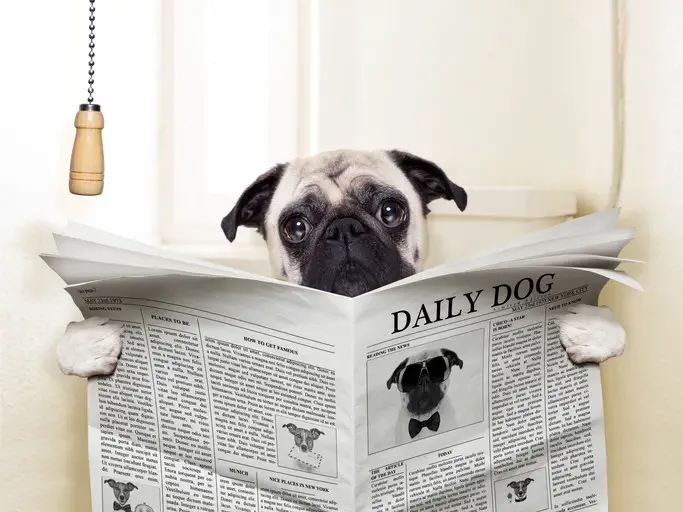Consistency and diligent supervision are the keys to success when it comes to knowing the right techniques on how to toilet train a puppy.
This is what dog care experts and experienced dog owners would recommend. Toilet training can be a frustrating endeavor.
It will involve a lot of patience from you, as well as a lot of cleaning up.
But your love for your dog and your desire to be successful should supersede your apprehension.
This will help prepare your dog for adulthood.
Below are a few FYIs and techniques to help you and your dog succeed and pass this phase with flying colors. There maybe some accidental poops here and there, but it will all be worth it.
1. Puppies need to toilet more frequently than adult dogs.
What to do:
Puppies have small bladders. It is not their fault that they need to go more frequently than an adult dog.
Be patient with them. Like babies, they are in that stage of rapid growth and development. At this stage, they still don’t have an instinct to “hold on.”
The question then is how would you know if your puppy needs to toilet? The usual signs would be when the dog starts circling around and sniffing. For adult dogs, that haven’t been toilet trained yet, you would need to take them out every 2 hours. For puppies, you would need to patiently and consistently take them out every hour to avoid messy clean-ups.
2. There is a need to always keep your puppy close to you or with you at all time during the duration of the toilet training.
What to do:
Time is a precious thing that you need to spend with your dog. However, if there will be times when you have to really leave your puppy on its own, you can use a playpen or a crate. Crate training is important especially if you are used to traveling, or being away for several hours in a day.
Consequently, you may also want to consider using puppy pads.
Puppy training pads can be your best friend. These pads can serve several purposes.
First is, it allows you to teach the behavior of having your dog toilet in the right place. The technique is to move these pads closer and closer to the door every time your dog toilets. This will teach them two things. They can recognize the pad as a place where they can “go” if they are crated. At the same time, they also gradually learn the rule that going outside the door is where they can actually toilet.
3. Repetition is the key to success.
What to do:
This is where an alarm clock can come in handy. This would be most helpful during the early stages of the training. Setting a timer to help remind you that you need to take your dog out will help your dog recognize the frequency.
4. Toileting on command works with the right technique.
What to do:
You can introduce to your puppy a cue word. It’s as simple as saying a cue word when your puppy starts to urinate or defecate. You can even use a whistle or a hand signal. If you do this consistently, your puppy will be able to pair the command with toileting. This will really come in handy especially when you bring your dog during travels, long trips or during the winter season.
5. Pick a single spot for toileting.
What to do:
Whether you live in a small apartment or a house with a big yard, it is important to pick a spot where your dog is allowed to do its thing. This basically means that when you let your dog out for its toilet time, don’t let it wander around and pick a spot to toilet. There should already be a tree or a space that your dog recognizes as a toilet spot. If you’re training your dog to toilet in your own yard, then make sure that you choose an area that is far from where kids play. This will also make clean up easier, rather than seeing brown patches everywhere in the yard.
6. Like humans, dogs get more motivated with a reward system.
What to do:
Praising is not enough. Your dog recognizes that it did something good, but it will respond more to training if you have a treat ready. You can definitely go over the top with your reward. You will notice that they will work harder once they know that they will get something good out of it.
 7. Punishment does not work.
7. Punishment does not work.
What to do:
If you search on google, “how to train my puppy”, you will see nothing there that indicates punishment as a good motivating tool. It works for kids sometimes, but it doesn’t work for dogs. When a dog gets punished, it will not learn anything. Your puppy will only be scared of you, and would end up demotivated to cooperate with you. It is really important to be patient.
8. Reading on other dog owner’s experiences can help you succeed.
What to do:
Go online and look up puppy obedience training or online puppy training. You will see lots of good materials that will help you be successful in your quest of finding different techniques on how to toilet train a puppy.
Will it be a trial and error thing? Yes, it could be. The most important thing that you need to realize is that it will not be an easy feat. You will also need to remember that just because you’re training your dog, doesn’t mean you no longer show the affection and care that it deserves. There will be accidents. You may need to clean up more than you should. Like a child, your puppy needs your guidance now more than ever. After all, you will soon reap the rewards of your hard work and this will be good for you, your household, and your dog in the long run. Go ahead and start your toilet training your puppy. There is nothing to be afraid of.







